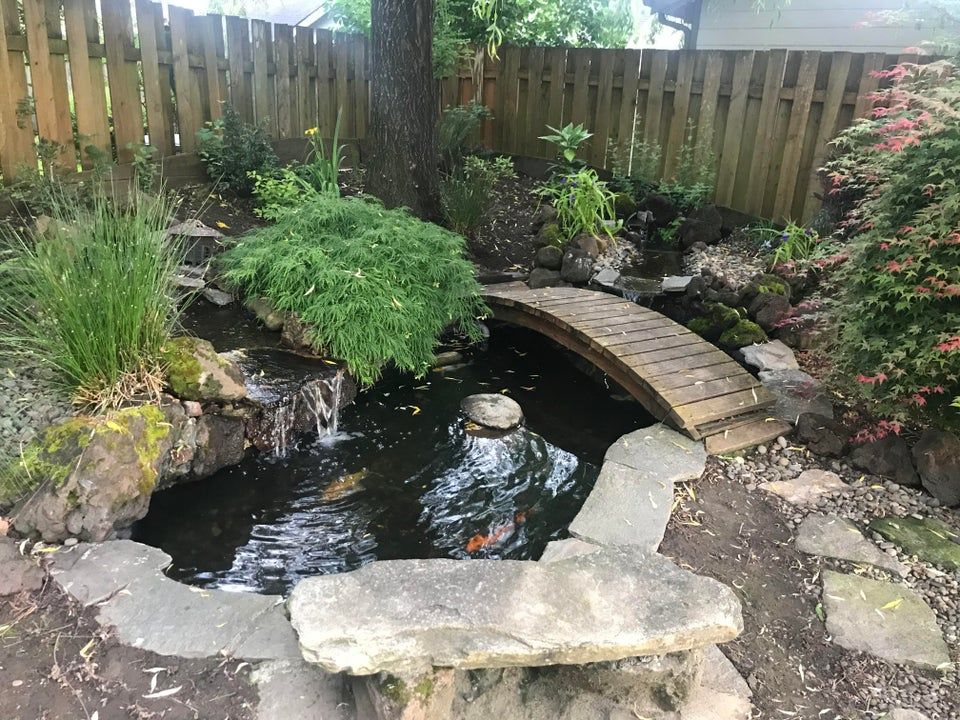Building a pond is very similar to buying a house. Your first home (or “starter home”) traditionally is smaller. You live in it for a couple of years, noting the things you’d change about it if you could. It gets smaller as time goes by and you yearn for a little more storage space or an office or den that you presently don’t have.
Many of us start with a small pond as well. Many use a preformed shell and a submersible pump system then, after a couple of years, it’s torn down and another built in its place or the second pond is built. There are some folks who are just starting out or want only a water feature to augment a lovely landscape. If you are one of those folks who wants to build a pond in about a day with a limited budget there are a few things you can do so that your “starter pond” is not a nightmare to maintain.
- Don’t use a preformed pond. Use liner instead. It comes in 10, 15, and 20 feet widths. Find more information about liner in the Water Garden Edition of What’s Up, Doc?.
- Choose a reliable submersible pump (such as a Cal Pump or Pond Master) and protect it with a pump basket. Do not line the basket with material or load it down with rocks.
- Place a filter outside the pond where you can get to it easier. This will remove the silt and muck from the pond while providing the biological necessities for fish and aquatic life. An Ocean Clear is a wonderful choice for a pond that is up to 600 gallons.
- Don’t line the bottom of the pond with rocks. Dirt and muck collect between the rocks causing a cleaning nightmare! Read more about this in our article “Turn Your Pond Into a Cess Pool in One Easy Lesson” from the Clear Water Edition of What’s Up, Doc?.
These types of ponds can completed in a weekend. Here are the basic steps to build one:
- First, draw with spray paint the shape of the pond. Where you will enjoy it most is the best location for it.
- Dig the pond. We suggest a part of it to be 3 ft. deep to protect the aquatic life from predators.
- Measure for the liner. For the most accurate measurement, place a string 18” as overlap on the outside of the hole then drop the string along the bottom of the pond to the other side then 18” as overlap there as well. Now, measure the string. Do the same for the length of the hole.
- Lay the liner folding it where necessary and make it neat.
- Place the pump in its pump basket and with hoses attached at the deepest end and furthest away from the water return as possible. This is also a great time to place plants where you want them to go if you have them ready.
- Fill the pond with water. Adjust the liner as necessary during the filling process.
- Build your waterfall. If you choose a waterfall as your water return you will need to place liner wherever your waterfall goes having it lap over the edge of the pond, place the rocks as you want.
- Attach your filter to the hose that comes from the pump. Cut the hose where the filter is to placed and simply attach each hose end to the intake and outgo of the filter. Note: This is if you use an Ocean Clear or other compressed unit. A gravity-fed filter will need to be placed so water spills out of the filter directly into the pond or waterfall.
- Place the hose from the filter into the waterfall where you want the water to come out of the rocks.
Now you can plug it in and enjoy!
This type of pond is very simple and the initial cost will not blow you out of the water. Weekly maintenance during pond season is a must and involves clearing the pump basket of large debris and cleaning the filter pads. By placing the filter on the outside of the pond you will save yourself a lot of time and energy. You will need to perform a thorough cleaning once or twice a year as with all ponds.
You will experience algae bloom (when the water heats up and turns green from algae) unless you place an ultraviolet water clarifier onto the system. If you have patience and enough plants (and all the right factors fall into place) sometimes Mother Nature balances the pond and clears the water naturally.
We do not carry pond kits (other than very small porch ponds and container water gardens) because they do not allow the flexibility needed for a natural original water feature. Most the time a pond kit contains a preformed shell and very few of them have a true filter. It’s so easy build a starter pond without a kit that a pond kit is simply not needed. As with everything we sell we are there to help you with putting it together.
